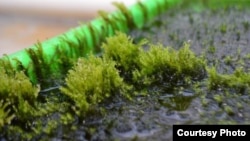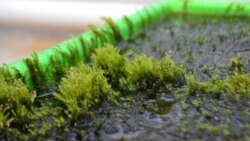ဒီတပတ်တော့ အာဆင်းနစ် အဆိပ်တွေနဲ့ ညစ်ညမ်းနေတဲ့ ရေကို ရေမှော်သုံးပြီး ဖယ်ရှား သန့်စင်နိုင်တာကို Sweden နိုင်ငံ Stockholm တက္ကသိုလ်က သုတေသန ပညာရှင်တွေ စမ်းသပ်တွေ့ရှိခဲ့တဲ့ အကြောင်း ပြောပြပေးမှာပါ။
Sweden နိုင်ငံ မြောက်ပိုင်းဒေသမှာ ရေထုညစ်ညမ်းမှုဒဏ်ကို အတော်ခံစားနေရတာပါ။ ဒါ့ကြောင့် ၂၀၀၄ ခုနှစ်ကစပြီး သစ်သားတွေ တာရှည်ခံအောင်လုပ်တဲ့ အာဆင်းနစ်ပါ ဓါတုဒြပ်ပေါင်းတွေ မသုံးစွဲဖို့ Sweden အစိုးရက တားမြစ်ခဲ့ပါတယ်။ အာဆင်းနစ်ပါတဲ့ ဒြပ်ပေါင်းတွေကို သစ်သားအတွက်သာမက ဆေးဝါးထုတ်လုပ်ရေး၊ စိုက်ပျိုးရေး၊ ဖန်ချက်လုပ်ငန်းနဲ့ သတ္တုတူးဖေါ်ရေး အပြင် semiconductor အဖြစ် အီလက်ထရောနစ်ပစ္စည်း စက်ရုံတွေမှာ သုံးလေ့ရှိပါတယ်။ ဒီဆွီဒင်နိုင်ငံမြောက်ပိုင်းမှာတော့ သတ္တုတူးဖေါ်ရေးလုပ်ငန်းကြောင့် အာဆင်းနစ် အဆိပ်သင့်မှုဟာ ဒေသတလွှား မြေပြင်မှာရော မြေအောက်ရေအထိကိုပါ သက်ရောက်မှု ရှိနေတာပါ။
တကယ်ဆိုတော့ အာဆင်းနစ်ပါဝင်နှုန်း ပမာဏအားဖြင့် သိပ်မသိသာတဲ့ trace level လောက် ရှိနေရင်ကို ဒီရေကို သောက်မိသူအတွက် ကင်ဆာရောဂါ ဖြစ်ပွါးနိုင်တဲ့ အန္တရာယ်ရှိနေသလို ခန္ဓာကိုယ်အတွက် မူမမှန်တဲ့ ထိခိုက်မှုတွေ ဖြစ်လာနိုင်တာပါ။ ဒါ့အပြင် ဒေသထွက် သီးနှံတွေမှာလည်း အာဆင်းနစ်ပါဝင်နှုန်း မြင့်တက်လာနိုင်ပါတယ်။
Stockholm တက္ကသိုလ်က သဘာဝဝန်းကျင်၊ ဂေဟစံနစ်နဲ့ ရုက္ခဗေဒ ဆိုင်ရာ တွဲဘက်ပါမောက္ခ Maria Greger ဟာ သူ့ရဲ့ ဆွီဒင်မြောက်ပိုင်းဒေသ သုတေသနခရီးမှာ Warnstofia Fluitans လို့ခေါ်တဲ့ ရေမှော်တမျိုးရဲ့ အစွမ်းကို သိခဲ့ရတာ ဖြစ်ပြီး ဒီရေမှော်မျိုးနဲ့ ပတ်သက်ပြီး ဓါတ်ခွဲခန်း စမ်းသပ်မှုတွေ လုပ်နေတယ်လို့ ပြောပါတယ်။
Maria Greger ။ ။ "မသန့်ရှင်းတဲ့ရေထဲမှာ ပါနေတဲ့ ညစ်ညမ်းတဲ့ဓါတ်တွေကို အပင်တွေနဲ့ ဖယ်ရှား ပစ်နိုင်မယ့်နည်းကို ကျမတို့စမ်းသပ်နေတာပါ။ ဆိုလိုတာက သဘာဝဝန်းကျင် သန့်ရှင်းအောင် အပင်တွေကို ဘယ်လောက်သုံးနိုင်တယ်ဆိုတာပါပဲ။ ဒါ့ကြောင့် ဒီရေမှော်ပင်မျိုးကို ရေသန့်စင်တဲ့ နေရာမှာ သုံးလို့ ရမရ၊ သူက အာဆင်းနစ်ကို ဘယ်လောက်စုပ်ယူနိုင်စွမ်းရှိတယ်၊ ရေကိုဘယ်လောက်သန့်စင်စေတယ် ဆိုတာတွေကို သိချင်တာနဲ့ ဓါတ်ခွဲခန်းကို ယူလာပြီး ဒီရောက်တော့ စမ်းသပ်ကြည့်တာပါ။
ဒီရေမှော်မျိုးဟာ တနာရီလောက်အတွင်းမှာပဲ ရေထဲက အာဆင်းနစ်တွေ အကုန်လုံးကို စုပ်ယူနိုင်တာမို့ သောက်သုံးနိုင်တဲ့ အန္တရာယ်ကင်းတဲ့ အဆင့်ကို ရောက်စေတာတွေ့ခဲ့ရပါတယ်။
Maria Greger ။ ။ “ဒီရေမှော်မျိုးက အာဆင်းနစ်တွေကို ကောင်းကောင်းစုပ်ယူပါတယ်။ အချိန်တိုတိုလေးအတွင်းမှာပဲ ရေထဲက အာဆင်းနစ်တွေ အားလုံးကို စုပ်ယူနိုင်တာပါ။ ဒါ့အပြင် ဒီရေမှော်မျိုးက အေးတဲ့နေရာတွေမှာလည်း ပေါက်နိုင်ပါတယ်။ တကယ်တော့ အေးတဲ့ ရာသီဥတုရှိတဲ့ နေရာတွေမှာ တနှစ်ပတ်လုံး ပေါက်နိုင်တဲ့ အပင်က သိပ်မရှိဘူးလေ။ ဒါ့ကြောင့် အအေးပိုင်း ဒေသတွေမှာလည်း သူ့ကိုသုံးလို့ ရပါတယ်။”
အအေးပိုင်း၊ အပူပိုင်း ဘယ်ဒေသမှာပဲ ဖြစ်ဖြစ်၊ မြစ်ချောင်း အင်းအိုင်တွေမှာ ညစ်ညမ်းတဲ့ ရေအဆိပ်သင့်မှုကို သန့်စင်ရာမှာ သုံးလို့ရတဲ့အထိ စဉ်းစားနေတယ်လို့လည်း Stockholm တက္ကသိုလ်က တွဲဘက်ပါမောက္ခ Greger ကပြောပါတယ်။
Maria Greger ။ ။ “ဒီရေမှော်တွေကို ကိုယ် သန့်စင်စေချင်တဲ့ ရေထဲမှာ တင်မကဘူး၊ wetland လို့ခေါ်တဲ့ စိုစွတ်တဲ့ စိမ့်မြေဒေသတွေမှာ ထည့်ထားပေးဖို့ပါ စဉ်းစားနေပါတယ်။ ဒါမှ ဒေသတွင်း အင်းအိုင် ချောင်းမြောင်းတွေကို သန့်စင်စေမယ့်အပြင် သူတို့နဲ့အတူရှိနေတဲ့ တခြားအပင်တွေကိုပါ သန့်စင်စေမှာ ဖြစ်ပါတယ်။ ဒါကြောင့် သဘာဝဥယာဉ်လို နေရာတွေကိုပါ သန့်စင်လာစေမယ် လို့ ပြောလို့ရပါတယ်။”
Warnstofia Fluitans ရေမှော်မျိုးအတွက်တင်မကပဲ နောက်တခြားရေမှော်အမျိုးအစားတွေကိုပါ ဆန်းစစ်ဖို့ ဆွီဒင်နိုင်ငံက သိပ္ပံပညာရှင်တွေ ကြိုးစားနေကြတာပါ။
Maria Greger ။ ။ “ဒီရေမှော်အမျိုးအစားလို စွမ်းဆောင်နိုင်တဲ့ တခြားအမျိုးအစားတွေကိုပါ တွေ့လာနိုင်မယ်လို့ ကျမထင်ပါတယ်။ ဒီအမျိုးအစားက အာဆင်းနစ်တင်မကပဲ တခြား သတ္တုအလေး တွေကိုပါ စုပ်ယူနိုင်တာ ကျမတို့ သေသေချာချာ သိရပါပြီ။ ဒါကြောင့် ဒီရေမှော်တွေကို ရေသန့်စင်ဖို့ သုံးနိုင်မယ့် အလားအလာ အများကြီးရှိနေပါတယ်။ အခုလို အအေးပိုင်းဒေသတွေတင် မကပဲ အပူပိုင်းဒေသတွေမှာပါ အလုပ်ဖြစ်နိုင်မယ်လို့ ထင်ပါတယ်။”
ဆွီဒင်မြောက်ပိုင်းက သံသတ္တုမိုင်းတွေကို သွားရောက်ခဲ့တဲ့ ပါမောက္ခ Greger နဲ့ အတူလိုက်ပါသွားသူ ကတော့ Stockholm တက္ကသိုလ်က သုတေသန လက်ထောက် Arifin Sandhi ပါ။ သူ့ဓါတ်ခွဲခန်း စမ်းသပ်ချက်တွေအရ ဒီရေမှော်ရဲ့အစွမ်းကို သိလာရတာမို့ အံ့ကြမိတယ်လို့ ပြောပါတယ်။
Arifin Sandhi ။ ။ ဒီရေမှော်ပင်မျိုးဟာ ရေထဲက အာဆင်းနစ်တွေ သန့်စင်ရာမှာ ကောင်းကောင်း သုံးနိုင်တာတွေ့ရပါတယ်။ ဒီ့အတွက် ကျွန်တော်တို့ သိပ်အံ့သြခဲ့ရပါတယ်။
ဒီလို ရေမှော်အမျိုးအစား မရနိုင်တဲ့ဒေသတွေမှာ ရေသန့်စင်ဖို့ အတွက်ကိုပါ စဉ်းစားပြီး သုတေသန လုပ်နေတာ ဖြစ်ပါတယ်။
Arifin Sandhi ။ ။ “ယေဘူူယျ ပြောရရင် အပင်အတော်များများဟာ heavy metals သတ္တုလေး မျိုးကွဲတွေကို စုပ်ယူနိုင်စွမ်းရှိပါတယ်။ ဒါပေမယ့် တချို့အပင်တွေက သူတို့ရဲ့ ရုပ်သွင် အနေထားအရ ပိုပြီး စုပ်ယူနိုင်စွမ်းရှိပါတယ်။ ဒီရေမှော်တွေကိုတော့ ဆွီဒင်က သံသတ္တုမိုင်းတွေမှာ သဘာဝ အလျှောက်ပေါက်နေတာ တွေ့ရပါတယ်။ ဒီဆွီဒင်မြောက်ပိုင်းဒေသမှာ သံပါတဲ့ pyrite လို့ခေါ်တဲ့ တွင်းထွက်တွေရှိနေပြီး အဲဒီထဲမှာ သံနဲ့ အာဆင်းနစ်ကို တွဲတွေ့ရပါတယ်။ ဒီအဆိပ်သင့်ဒေသမှာ ဒီရေမှော်တွေဟာ သူတို့ရှင်သန်ဖို့အတွက် အာဆင်းနစ်ကို စုပ်ယူရတဲ့ အနေထားဖြစ်ပါတယ်။ ဒါကြောင့် ဒီဒေသမှာ သူတို့ကို တွေ့တွေ့ချင်း သူတို့ကို သုံးနိုင်မသုံးနိုင် စမ်းသပ်ကြည့်ဖို့ စဉ်းစားခဲ့တာ ဖြစ်ပါတယ်။ တကယ်ဆိုတော့ အပင်နဲ့ ရေသန့်စင်အောင် လုပ်ရာမှာ ဒီလို ရေမှော်မျိုး မရနိုင်တဲ့ဒေသတွေအတွက် သုံးနိုင်မလားဆိုတာကိုပါ စမ်းသပ်ကြည့်တာပါ။”
တွဲဘက်ပါမောက္ခ Maria Greger နဲ့ သူ့အဖွဲ့သားတွေဟာ phytoremediation လို့ခေါ်တဲ့ အပင်တွေကို သုံးပြီး ရေသန့်စင်ဖို့ သုတေသန လုပ်နေကြတာ ဖြစ်ပါတယ်။
အခု သုတေသနပညာရှင်တွေရဲ့ တွေ့ရှိချက်ကနေ ရေထဲမှာ ပါနေတဲ့ အာဆင်းနစ်အဆိပ် ဓါတ်တွေကို သဘာဝဝန်းကျင်နဲ့ လိုက်လျောညီထွေ ကျယ်ကျယ်ပြန့်ပြန့် နေရာဒေသအတော်များများအတွက် ဖြေရှင်းနိုင်မယ်လို့ မျှော်လင့်နေကြပါတယ်။
ဒီရေမှော်တွေကို မြစ်ချောင်းတွေနဲ့ အာဆင်းနစ်ပါဝင်နှုန်းမြင့်တဲ့ ရေစီးရေလာရှိတဲ့ နေရာတွေမှာ စိုက်ပျိုးနိုင်တဲ့ အနေထားလည်း ရှိနေပါတယ်။ ဒါ့ကြောင့် ရေမှော်တွေကို သုတေသနလုပ်နေတဲ့ Arifin Sandhi က ကမ္ဘာ့တခြားနေရာတွေမှာ တကယ်လို့ ဒီလို ရေမှော်မျိုးတွေ ရနိုင်မယ်ဆိုရင် အခုလို ရေသန့်စင်မှုတွေ လုပ်လို့ ရနိုင်တဲ့အကြောင်း ပြောကြားခဲ့တာကို တင်ပြရင်း ဒီသီတင်းပတ်အတွက် သိပ္ပံနဲ့ နည်းပညာကဏ္ဍကို ဒီမှာပဲ ရပ်နားလိုက်ပါရစေ။
Environmental Pollution, Volume 237, June 2018, Pages 1098-1105
Phytofiltration of arsenic by aquatic moss (Warnstorfia fluitans)
Highlights
•W. fluitans removed up to 82% arsenic from water within an hour.
•As removal rate was highest at 1 μM As and no nutrients in the water.
•W. fluitans removes both arsenite and arsenate from water.
•Most accumulated As species were bounded in moss biomass tissue.
•Both dead and living moss can reduce As from water.
Abstract
This work investigates whether aquatic moss (Warnstorfia fluitans) originating from an arsenic (As)-contaminated wetland close to a mine tailings impoundment may be used for phytofiltration of As. The aim was to elucidate the capacity of W. fluitans to remove As from arsenite and arsenate contaminated water, how nutrients affect the As uptake and the proportion of As adsorption and absorption by the moss plant, which consists of dead and living parts.
Arsenic removal from 0, 1, or 10% Hoagland nutrient solution containing 0–100 μM arsenate was followed over 192 h, and the total As in aquatic moss after treatment was analysed. The uptake and speciation of As in moss cultivated in water containing 10 μM arsenate or arsenite were examined as As uptake in living (absorption + adsorption) and dead (adsorption) plant parts.
Results indicated that W. fluitans removed up to 82% of As from the water within one hour when 1 μM arsenate was added in the absence of nutrients. The removal time increased with greater nutrient and As concentrations. Up to 100 μM As had no toxic effect on the plant biomass. Both arsenite and arsenate were removed from the solution to similar extents and, independent of the As species added, more arsenate than arsenite was found in the plant. Of the As taken up, over 90% was firmly bound to the tissue, a possible mechanism for resisting high As concentrations. Arsenic was both absorbed and adsorbed by the moss, and twice as much As was found in living parts as in dead moss tissue. This study revealed that W. fluitans has potential to serve as a phytofilter for removing As from As-contaminated water without displaying any toxic effects of the metalloid.














